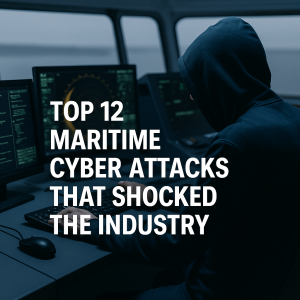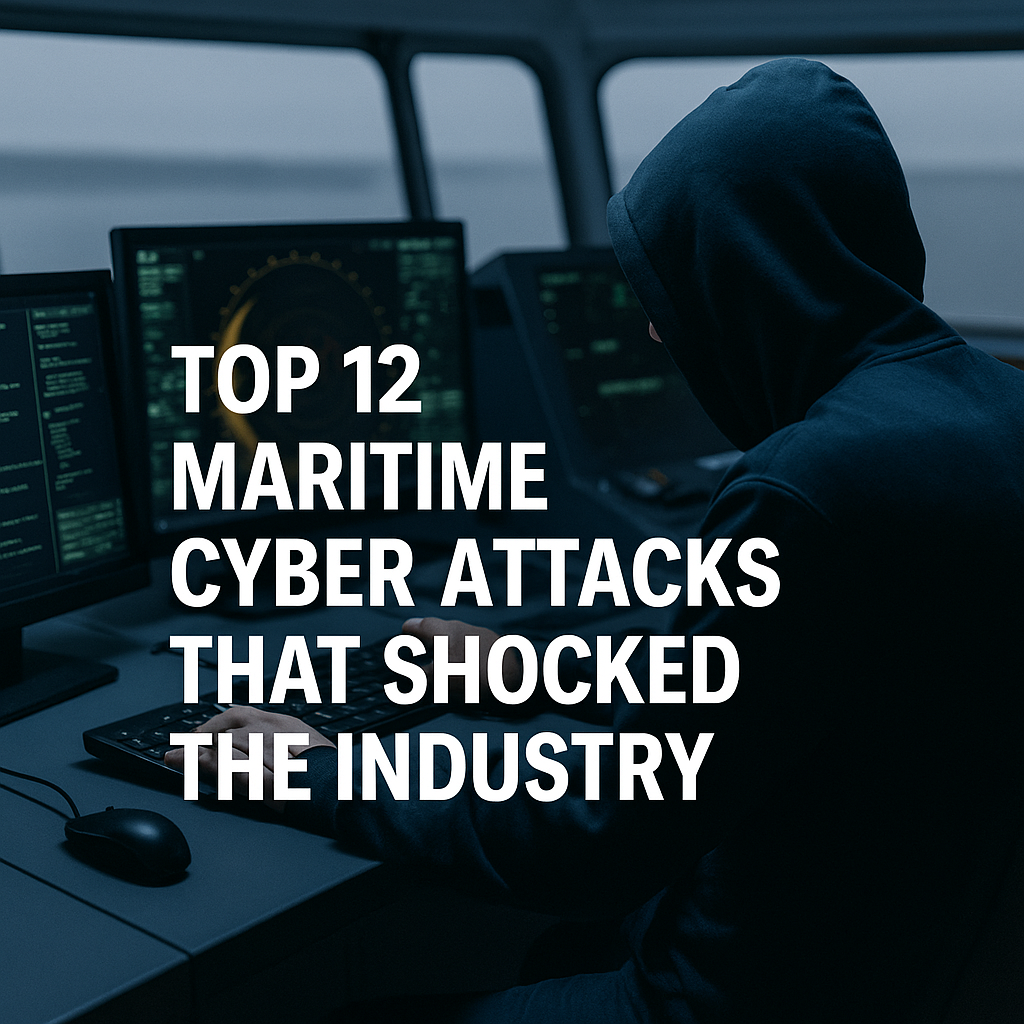 Twelve real-world cyber-attacks exposed just how vulnerable modern shipping can be. From Maersk’s global shutdown to port ransomware and GPS spoofing, discover how these incidents disrupted fleets, ports, and cargo systems—and what lessons every maritime professional should learn.
Twelve real-world cyber-attacks exposed just how vulnerable modern shipping can be. From Maersk’s global shutdown to port ransomware and GPS spoofing, discover how these incidents disrupted fleets, ports, and cargo systems—and what lessons every maritime professional should learn.
When the world thinks of maritime disasters, it imagines oil spills or collisions. Yet in the digital century, one of the most dangerous forces at sea doesn’t come from storms or reefs—it comes from keyboards.
Every modern ship and port now relies on integrated IT and OT systems: navigation, propulsion, cargo management, port logistics, and communications all networked together. That digital transformation brought efficiency—and opened the door to cyber threats. A single virus or phishing email can now halt a global supply chain.
Why cyber security matters in modern maritime operations
According to the International Maritime Organization (IMO), maritime transport moves over 90 % of global trade. That scale makes shipping a tempting target for hackers seeking ransom, espionage, or chaos.
Since 2020, cyber incidents against shipping have quadrupled, with ransomware and phishing dominating reports to classification societies such as DNV and Bureau Veritas. In response, the IMO’s Resolution MSC.428(98) requires all Safety Management Systems (SMS) to include cyber-risk management by design.
But rules alone cannot stop an attack. Only awareness, teamwork, and preparedness can.
–
The 12 Cyber Incidents That Changed Maritime Security
1. Maersk – The NotPetya Ransomware (2017)
What happened:
In June 2017, the world’s largest container line Maersk was crippled when the NotPetya malware spread from a Ukrainian accounting system into its global network.
Operational impact:
-
4 000 servers and 45 000 PCs wiped.
-
600 sites in 130 countries offline.
-
Container tracking and port operations frozen.
A single infected computer in Odessa eventually cost Maersk over $300 million and shut down 17 terminals for 10 days.
Lesson learned:
Back-ups save businesses. Maersk restored its data using one surviving domain controller in Ghana—proof that offline redundancy is priceless.
2. COSCO Shipping Lines Ransomware (2018)
What happened:
A ransomware attack hit COSCO’s North American network, blocking email and booking systems.
Operational impact:
While ships kept sailing, port offices and cargo scheduling collapsed. Agents reverted to phone calls and paper manifests, delaying containers for days.
Lesson learned:
Segmentation matters. COSCO’s Asian and European networks were isolated, allowing partial continuity. Compartmentalization is digital damage control.
3. Port of San Diego – Ransomware (2018)
What happened:
An unknown actor deployed ransomware against the Port of San Diego’s administrative systems.
Operational impact:
Harbor police dispatch, public records, and billing systems were knocked offline for a week, forcing manual permit processing and delayed vessel clearances.
Lesson learned:
Cybersecurity is part of port resilience. Recovery plans must include manual operations to keep essential services running while networks are down.
4. APM Terminals Rotterdam – Collateral Damage from NotPetya (2017)
What happened:
The virus that paralyzed Maersk also disabled its subsidiary APM Terminals at Rotterdam and Mumbai.
Operational impact:
-
Gate operations stopped.
-
5 000 trucks queued for kilometers.
-
Crane automation suspended.
Manual re-entry of data took weeks. The incident demonstrated that a shore attack can instantly affect floating assets worldwide.
Lesson learned:
Port IT is ship IT. They must share resilience planning and communication channels during crises.
5. IMO Headquarters Cyber Breach (2020)
What happened:
The International Maritime Organization’s own website and email servers were taken offline after a sophisticated breach during pandemic lockdowns.
Operational impact:
The IMO GISIS database and online convention resources were unavailable for several days, disrupting flag state reporting and port inspections worldwide.
Lesson learned:
No organization is too big to be targeted. Even regulators must practice the security standards they set.
6. Port of Antwerp – Drug Cartel Hack (2011-2013)
What happened:
A European drug syndicate hired hackers to infiltrate container terminals in Antwerp. They modified cargo data to divert specific containers carrying narcotics.
Operational impact:
For two years, criminals retrieved containers before official owners arrived. When ports noticed missing boxes, law enforcement uncovered the breach.
Lesson learned:
Cybercrime can blend with physical smuggling. Port security must integrate digital and physical intelligence systems.
7. CMA CGM Ransomware (2020)
What happened:
CMA CGM announced a cyber-attack that shut down booking and documentation portals worldwide. The culprit was ransomware from the “Ragnar Locker” group.
Operational impact:
Customers lost access to shipment tracking and customs documents for a week. Agents re-entered data manually.
Lesson learned:
Transparency protects trust. By openly informing clients and cooperating with authorities, CMA CGM avoided panic and legal repercussions.
8. Hutchison Ports – Hong Kong System Outage (2021)
What happened:
A malware attack disrupted container operations at Hong Kong and Yantian.
Operational impact:
Yard management and vessel scheduling systems froze. Hundreds of vessels faced delays exceeding 72 hours.
Lesson learned:
Global terminals depend on shared software vendors. Third-party risk assessment is as crucial as internal security audits.
9. Svitzer Australia – Internal Data Leak (2018)
What happened:
Tug operator Svitzer discovered that crew and payroll data had been leaking for 18 months due to misconfigured email rules.
Operational impact:
Though not a malware attack, the breach eroded trust and required a complete rebuild of internal communication protocols.
Lesson learned:
Cyber incidents aren’t always attacks. Human error and poor settings can expose as much as a hacker.
10. Iranian GPS Spoofing and AIS Manipulation (2019)
What happened:
Dozens of commercial ships in the Persian Gulf reported GPS positions that placed them miles inland. Analysts believed state-sponsored actors were testing electronic warfare systems.
Operational impact:
Masters lost confidence in electronic navigation and relied on visual fixes and dead reckoning. Insurance premiums for the region briefly spiked.
Lesson learned:
Cyber risk isn’t only IT—it’s navigation too. ECDIS and AIS data should never replace visual watchkeeping or radar cross-checks.
11. Port of Ningbo-Zhoushan – Ransomware (2022)
What happened:
China’s busiest port suffered a major network shutdown after ransomware infiltrated its logistics systems.
Operational impact:
Terminal booking and cargo release functions froze for days, creating queues that rippled through global shipping schedules.
Lesson learned:
Critical infrastructure needs isolation zones between public internet and operational technology (OT). Firewalls alone aren’t enough.
12. Royal Dirkzwager – Supply Chain Ripple (2023)
What happened:
Dutch maritime logistics company Royal Dirkzwager was hit by ransomware that disrupted port arrival notifications and vessel ETA services across Europe.
Operational impact:
Thousands of port calls lacked timely data. Tug and pilot scheduling broke down for several days, causing delays and financial losses to operators.
Lesson learned:
Maritime supply chains are deeply interconnected. A cyber attack on a small data provider can affect an entire region’s port ecosystem.
Patterns and lessons across the twelve cases
-
Interconnectivity is risk. From shipping lines to port authorities to cargo brokers, one breach spreads like oil on water.
-
Ransomware remains the top threat. Attackers exploit unpatched software and weak remote access controls.
-
Manual fallback plans save time. When digital systems fail, paper and radio can still move cargo if crews are trained.
-
Transparency reduces panic. Quick public statements and cooperation with authorities maintain trust.
-
Cyber and physical security must merge. Ports are hybrid ecosystems where hackers can enable smugglers or pirates.
Building resilience after shock
Integrating cyber risk into the Safety Management System
The IMO mandates that cyber risk be treated like any other hazard. Companies should map digital assets, identify threats, and test response plans annually.
Crew training and culture
Phishing emails still cause most breaches. Regular training and simple habits—strong passwords, USB control, two-factor authentication—create human firewalls.
Collaboration with class societies
Organizations such as DNV, ABS, and Lloyd’s Register now offer cyber notation for ships and ports, verifying security architecture and incident response protocols.
Incident reporting and information sharing
Platforms like IMO GISIS, EMSA’s MAR-Cyber, and BIMCO’s Guarded network encourage sharing of anonymized incident data to spot patterns and update best practices.
Frequently Asked Questions
1. What is the most common type of cyber attack in shipping?
Ransomware and phishing remain the most frequent, often through compromised email accounts or third-party vendors.
2. Can a ship be hijacked remotely?
While complete takeover is rare, navigation systems like ECDIS and AIS can be spoofed or jammed, creating dangerous situations.
3. How can ports reduce their exposure?
Segment IT and OT networks, enforce multi-factor authentication, and conduct regular penetration testing with certified auditors.
4. Are crew members responsible for cyber incidents?
Usually not individually, but training is their first defence. Human error is a factor in over 90 % of breaches.
5. What is the role of the IMO in cyber security?
The IMO sets global guidelines and requires cyber risk to be addressed in the ISM Code from 2021 onwards.
6. How much damage can a cyber attack cost a shipping company?
From hundreds of thousands for minor outages to hundreds of millions for global shutdowns—as Maersk’s $300 million loss proved.
7. Is cyber insurance effective for shipowners?
Yes, but policies often exclude nation-state attacks or acts of war. Owners must read terms carefully and maintain preventive controls.
Conclusion
Cyber attacks have become the new storms of shipping. They strike without warning, cross oceans instantly, and can paralyze entire fleets. Yet each incident has taught the industry something vital: that digital security is now part of seamanship.
From Maersk’s global shutdown to GPS spoofing in the Gulf, every lesson points to the same truth—technology is only as safe as the people who guard it. For students, engineers, and captains alike, the future of shipping depends not just on stronger hulls but on smarter cyber habits. ⚓
References (Hyperlinked)
-
International Maritime Organization (IMO) – Maritime Cyber Risk Management in Safety Management Systems (MSC.428 (98)) → imo.org
-
BIMCO & ICS – *Guidelines on Cyber

